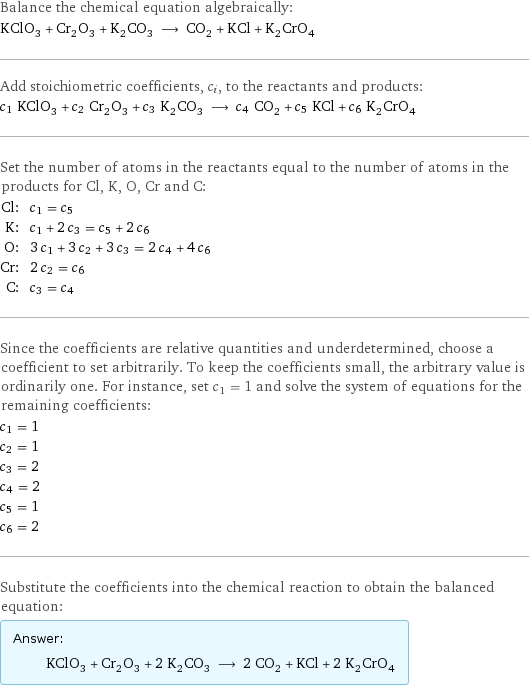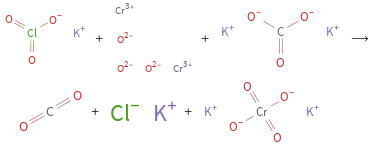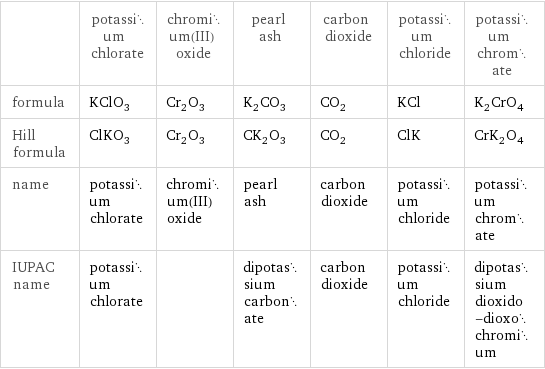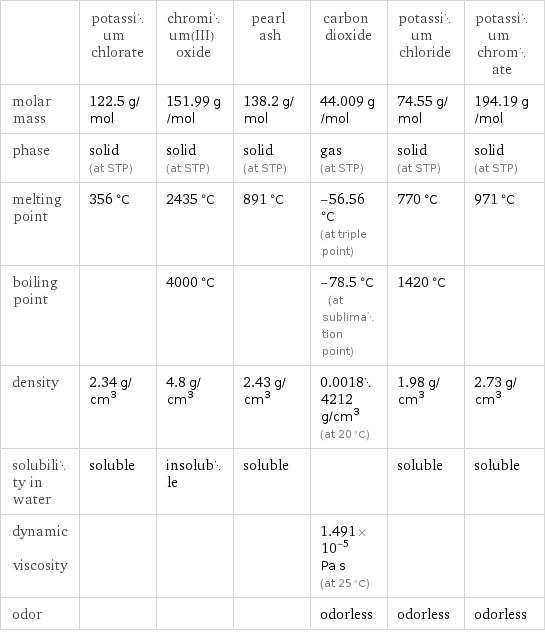Input interpretation

KClO_3 potassium chlorate + Cr_2O_3 chromium(III) oxide + K_2CO_3 pearl ash ⟶ CO_2 carbon dioxide + KCl potassium chloride + K_2CrO_4 potassium chromate
Balanced equation

Balance the chemical equation algebraically: KClO_3 + Cr_2O_3 + K_2CO_3 ⟶ CO_2 + KCl + K_2CrO_4 Add stoichiometric coefficients, c_i, to the reactants and products: c_1 KClO_3 + c_2 Cr_2O_3 + c_3 K_2CO_3 ⟶ c_4 CO_2 + c_5 KCl + c_6 K_2CrO_4 Set the number of atoms in the reactants equal to the number of atoms in the products for Cl, K, O, Cr and C: Cl: | c_1 = c_5 K: | c_1 + 2 c_3 = c_5 + 2 c_6 O: | 3 c_1 + 3 c_2 + 3 c_3 = 2 c_4 + 4 c_6 Cr: | 2 c_2 = c_6 C: | c_3 = c_4 Since the coefficients are relative quantities and underdetermined, choose a coefficient to set arbitrarily. To keep the coefficients small, the arbitrary value is ordinarily one. For instance, set c_1 = 1 and solve the system of equations for the remaining coefficients: c_1 = 1 c_2 = 1 c_3 = 2 c_4 = 2 c_5 = 1 c_6 = 2 Substitute the coefficients into the chemical reaction to obtain the balanced equation: Answer: | | KClO_3 + Cr_2O_3 + 2 K_2CO_3 ⟶ 2 CO_2 + KCl + 2 K_2CrO_4
Structures

+ + ⟶ + +
Names

potassium chlorate + chromium(III) oxide + pearl ash ⟶ carbon dioxide + potassium chloride + potassium chromate
Equilibrium constant
![Construct the equilibrium constant, K, expression for: KClO_3 + Cr_2O_3 + K_2CO_3 ⟶ CO_2 + KCl + K_2CrO_4 Plan: • Balance the chemical equation. • Determine the stoichiometric numbers. • Assemble the activity expression for each chemical species. • Use the activity expressions to build the equilibrium constant expression. Write the balanced chemical equation: KClO_3 + Cr_2O_3 + 2 K_2CO_3 ⟶ 2 CO_2 + KCl + 2 K_2CrO_4 Assign stoichiometric numbers, ν_i, using the stoichiometric coefficients, c_i, from the balanced chemical equation in the following manner: ν_i = -c_i for reactants and ν_i = c_i for products: chemical species | c_i | ν_i KClO_3 | 1 | -1 Cr_2O_3 | 1 | -1 K_2CO_3 | 2 | -2 CO_2 | 2 | 2 KCl | 1 | 1 K_2CrO_4 | 2 | 2 Assemble the activity expressions accounting for the state of matter and ν_i: chemical species | c_i | ν_i | activity expression KClO_3 | 1 | -1 | ([KClO3])^(-1) Cr_2O_3 | 1 | -1 | ([Cr2O3])^(-1) K_2CO_3 | 2 | -2 | ([K2CO3])^(-2) CO_2 | 2 | 2 | ([CO2])^2 KCl | 1 | 1 | [KCl] K_2CrO_4 | 2 | 2 | ([K2CrO4])^2 The equilibrium constant symbol in the concentration basis is: K_c Mulitply the activity expressions to arrive at the K_c expression: Answer: | | K_c = ([KClO3])^(-1) ([Cr2O3])^(-1) ([K2CO3])^(-2) ([CO2])^2 [KCl] ([K2CrO4])^2 = (([CO2])^2 [KCl] ([K2CrO4])^2)/([KClO3] [Cr2O3] ([K2CO3])^2)](../image_source/7bff114676158fe92d6dde8c8ceeef7a.png)
Construct the equilibrium constant, K, expression for: KClO_3 + Cr_2O_3 + K_2CO_3 ⟶ CO_2 + KCl + K_2CrO_4 Plan: • Balance the chemical equation. • Determine the stoichiometric numbers. • Assemble the activity expression for each chemical species. • Use the activity expressions to build the equilibrium constant expression. Write the balanced chemical equation: KClO_3 + Cr_2O_3 + 2 K_2CO_3 ⟶ 2 CO_2 + KCl + 2 K_2CrO_4 Assign stoichiometric numbers, ν_i, using the stoichiometric coefficients, c_i, from the balanced chemical equation in the following manner: ν_i = -c_i for reactants and ν_i = c_i for products: chemical species | c_i | ν_i KClO_3 | 1 | -1 Cr_2O_3 | 1 | -1 K_2CO_3 | 2 | -2 CO_2 | 2 | 2 KCl | 1 | 1 K_2CrO_4 | 2 | 2 Assemble the activity expressions accounting for the state of matter and ν_i: chemical species | c_i | ν_i | activity expression KClO_3 | 1 | -1 | ([KClO3])^(-1) Cr_2O_3 | 1 | -1 | ([Cr2O3])^(-1) K_2CO_3 | 2 | -2 | ([K2CO3])^(-2) CO_2 | 2 | 2 | ([CO2])^2 KCl | 1 | 1 | [KCl] K_2CrO_4 | 2 | 2 | ([K2CrO4])^2 The equilibrium constant symbol in the concentration basis is: K_c Mulitply the activity expressions to arrive at the K_c expression: Answer: | | K_c = ([KClO3])^(-1) ([Cr2O3])^(-1) ([K2CO3])^(-2) ([CO2])^2 [KCl] ([K2CrO4])^2 = (([CO2])^2 [KCl] ([K2CrO4])^2)/([KClO3] [Cr2O3] ([K2CO3])^2)
Rate of reaction
![Construct the rate of reaction expression for: KClO_3 + Cr_2O_3 + K_2CO_3 ⟶ CO_2 + KCl + K_2CrO_4 Plan: • Balance the chemical equation. • Determine the stoichiometric numbers. • Assemble the rate term for each chemical species. • Write the rate of reaction expression. Write the balanced chemical equation: KClO_3 + Cr_2O_3 + 2 K_2CO_3 ⟶ 2 CO_2 + KCl + 2 K_2CrO_4 Assign stoichiometric numbers, ν_i, using the stoichiometric coefficients, c_i, from the balanced chemical equation in the following manner: ν_i = -c_i for reactants and ν_i = c_i for products: chemical species | c_i | ν_i KClO_3 | 1 | -1 Cr_2O_3 | 1 | -1 K_2CO_3 | 2 | -2 CO_2 | 2 | 2 KCl | 1 | 1 K_2CrO_4 | 2 | 2 The rate term for each chemical species, B_i, is 1/ν_i(Δ[B_i])/(Δt) where [B_i] is the amount concentration and t is time: chemical species | c_i | ν_i | rate term KClO_3 | 1 | -1 | -(Δ[KClO3])/(Δt) Cr_2O_3 | 1 | -1 | -(Δ[Cr2O3])/(Δt) K_2CO_3 | 2 | -2 | -1/2 (Δ[K2CO3])/(Δt) CO_2 | 2 | 2 | 1/2 (Δ[CO2])/(Δt) KCl | 1 | 1 | (Δ[KCl])/(Δt) K_2CrO_4 | 2 | 2 | 1/2 (Δ[K2CrO4])/(Δt) (for infinitesimal rate of change, replace Δ with d) Set the rate terms equal to each other to arrive at the rate expression: Answer: | | rate = -(Δ[KClO3])/(Δt) = -(Δ[Cr2O3])/(Δt) = -1/2 (Δ[K2CO3])/(Δt) = 1/2 (Δ[CO2])/(Δt) = (Δ[KCl])/(Δt) = 1/2 (Δ[K2CrO4])/(Δt) (assuming constant volume and no accumulation of intermediates or side products)](../image_source/08515999aa88f0824ec4f72232bd16ce.png)
Construct the rate of reaction expression for: KClO_3 + Cr_2O_3 + K_2CO_3 ⟶ CO_2 + KCl + K_2CrO_4 Plan: • Balance the chemical equation. • Determine the stoichiometric numbers. • Assemble the rate term for each chemical species. • Write the rate of reaction expression. Write the balanced chemical equation: KClO_3 + Cr_2O_3 + 2 K_2CO_3 ⟶ 2 CO_2 + KCl + 2 K_2CrO_4 Assign stoichiometric numbers, ν_i, using the stoichiometric coefficients, c_i, from the balanced chemical equation in the following manner: ν_i = -c_i for reactants and ν_i = c_i for products: chemical species | c_i | ν_i KClO_3 | 1 | -1 Cr_2O_3 | 1 | -1 K_2CO_3 | 2 | -2 CO_2 | 2 | 2 KCl | 1 | 1 K_2CrO_4 | 2 | 2 The rate term for each chemical species, B_i, is 1/ν_i(Δ[B_i])/(Δt) where [B_i] is the amount concentration and t is time: chemical species | c_i | ν_i | rate term KClO_3 | 1 | -1 | -(Δ[KClO3])/(Δt) Cr_2O_3 | 1 | -1 | -(Δ[Cr2O3])/(Δt) K_2CO_3 | 2 | -2 | -1/2 (Δ[K2CO3])/(Δt) CO_2 | 2 | 2 | 1/2 (Δ[CO2])/(Δt) KCl | 1 | 1 | (Δ[KCl])/(Δt) K_2CrO_4 | 2 | 2 | 1/2 (Δ[K2CrO4])/(Δt) (for infinitesimal rate of change, replace Δ with d) Set the rate terms equal to each other to arrive at the rate expression: Answer: | | rate = -(Δ[KClO3])/(Δt) = -(Δ[Cr2O3])/(Δt) = -1/2 (Δ[K2CO3])/(Δt) = 1/2 (Δ[CO2])/(Δt) = (Δ[KCl])/(Δt) = 1/2 (Δ[K2CrO4])/(Δt) (assuming constant volume and no accumulation of intermediates or side products)
Chemical names and formulas

| potassium chlorate | chromium(III) oxide | pearl ash | carbon dioxide | potassium chloride | potassium chromate formula | KClO_3 | Cr_2O_3 | K_2CO_3 | CO_2 | KCl | K_2CrO_4 Hill formula | ClKO_3 | Cr_2O_3 | CK_2O_3 | CO_2 | ClK | CrK_2O_4 name | potassium chlorate | chromium(III) oxide | pearl ash | carbon dioxide | potassium chloride | potassium chromate IUPAC name | potassium chlorate | | dipotassium carbonate | carbon dioxide | potassium chloride | dipotassium dioxido-dioxochromium
Substance properties

| potassium chlorate | chromium(III) oxide | pearl ash | carbon dioxide | potassium chloride | potassium chromate molar mass | 122.5 g/mol | 151.99 g/mol | 138.2 g/mol | 44.009 g/mol | 74.55 g/mol | 194.19 g/mol phase | solid (at STP) | solid (at STP) | solid (at STP) | gas (at STP) | solid (at STP) | solid (at STP) melting point | 356 °C | 2435 °C | 891 °C | -56.56 °C (at triple point) | 770 °C | 971 °C boiling point | | 4000 °C | | -78.5 °C (at sublimation point) | 1420 °C | density | 2.34 g/cm^3 | 4.8 g/cm^3 | 2.43 g/cm^3 | 0.00184212 g/cm^3 (at 20 °C) | 1.98 g/cm^3 | 2.73 g/cm^3 solubility in water | soluble | insoluble | soluble | | soluble | soluble dynamic viscosity | | | | 1.491×10^-5 Pa s (at 25 °C) | | odor | | | | odorless | odorless | odorless
Units
